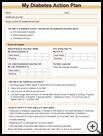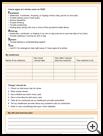
Diabetes and Exercise
________________________________________________________________________
KEY POINTS
- Having diabetes means that there is too much sugar (glucose) in your blood. Exercise helps your body burn more sugar and use insulin better. Exercise can help you lose weight and keep a normal weight. It also helps lower blood pressure and keep blood fat levels normal.
- Make sure you talk with your healthcare provider before you start an exercise program.
- If you take insulin or other diabetes medicines, be careful that your blood sugar doesn’t get too low when you exercise. You can avoid problems by keeping good exercise records and learning when to check your blood sugar and how to adjust your medicine, what you eat, and your exercise schedule.
________________________________________________________________________
What is diabetes?
Having diabetes means that there is too much sugar (glucose) in your blood. Your body breaks down some of the foods you eat into sugar. Your blood carries the sugar to the cells of your body. You need some sugar in your cells for energy, but too much sugar in your blood is not good for your health.
Diabetes is caused by a problem with the way your body makes or uses insulin. Insulin is made by the pancreas, which is an organ in your upper belly. Your body uses insulin to help move sugar from the blood into the cells. When you do not have enough insulin or you have trouble using the insulin your body makes, sugar cannot get into your cells and builds up in your blood.
Why is exercise important when I have diabetes?
Exercise can help you in many ways:
- It helps your body burn more sugar. Your body is able to use insulin better during exercise. As a result, exercise usually helps lower blood sugar.
- It makes you feel better. You will have more energy and tire less easily. Exercise can also lift your mood when you feel down and help reduce stress.
- It helps keep your body in good shape. Exercise can help you lose weight and keep a normal weight. It also keeps your muscles and bones strong.
- It helps keep your heart rate and blood pressure lower. This helps prevent stroke and problems with the heart, eyes, and kidneys.
- It helps keep blood fat levels normal. Many people with diabetes have high levels of blood fats (cholesterol and triglycerides). High blood fats can lead to blockage of blood vessels. Exercise and a healthy diet are the best ways to keep blood fats low.
- It helps you have normal blood flow to your feet. This can help prevent foot problems.
Which kinds of exercise are best?
The best exercise is exercise you enjoy. It is easier to make a habit of exercising if you enjoy the activity. If you have eye problems, make sure you talk to your healthcare provider before you start a new activity. Boxing, jogging, or weight lifting may increase your risk of eye injuries.
Warming up and cooling down
Muscles that are warmed-up before exercise are more flexible and less likely to be injured. Brisk walking, easy jogging, or jumping jacks are good ways to get your muscles warm and ready to go. After your muscles are warmed up, you may also want to stretch. Some people feel better if they stretch before and after exercise. Stretching after exercise is more important than stretching before exercise. It decreases the risk for being sore or injured. When you are ready to stop, cool down by gradually slowing your activity.
Aerobic exercise
Aerobic exercise increases your breathing and heart rate. This is important because it helps keep your heart and lungs healthy. Examples include walking, swimming, riding a bike, and dancing. If you have nerve damage or foot problems, it’s best to avoid walking long distances and treadmill or step exercises. Instead try activities like bicycling or swimming.
A healthy goal is to exercise for 2 hours and 30 minutes or more each week, in addition to your regular activities. You don't need to do 30 minutes of activity all at once. You can do shorter periods, at least 10 minutes each time. Aim for a moderate level of effort that lets you talk while moving, but without getting out of breath.
Strengthening
Exercise to strengthen all of your major muscle groups (legs, back, chest, belly, and arms) is recommended for most people. It includes weight lifting, stair stepping, carrying groceries, doing sit-ups or push-ups, and exercising with large elastic bands. Strength training can help you control your blood sugar. Muscle mass burns more calories than fat, so as your muscle increases, so does your ability to burn calories. A healthy goal is to do strengthening exercises on 2 days each week (skip at least 1 day in between). However, this kind of exercise can be harmful if you have certain medical conditions, such as high blood pressure. Always check with your healthcare provider about the best exercise program for you.
Flexibility
Flexibility exercises can help you move about more easily and have better posture. Being flexible makes it easier to do many activities and also decreases your risk for getting hurt. Examples include stretching, yoga, and tai chi.
How do I get started?
- Make sure you talk with your healthcare provider before you start an exercise program.
- It’s always best to start a new exercise program slowly. Slowly increase how long and how hard you exercise.
- If you are taking insulin or other diabetes medicines, ask your provider when you need to check your blood sugar. Also ask if you need to test for ketones, and how doses of insulin may need to be adjusted before and after exercise.
- Keep sugar tablets or a high carbohydrate and protein snack (such as crackers with cheese or peanut butter) on hand in case your blood sugar drops during or after exercise.
- Make exercise a daily routine. Be patient. It may take several months of exercising before you see changes in your health.
- Protect your feet when you exercise. Wear good-fitting shoes and smooth-fitting socks. Check your feet every day and watch for blisters, warm areas, or redness. If you have any kind of sore on your foot, see your healthcare provider right away. If you have foot problems cause by diabetes, bicycling or swimming may be safer for you than walking or running.
When should I not exercise?
If you have type 1 diabetes, you should avoid vigorous physical activity when your urine or blood test is positive for ketones. If your urine ketone level is large or moderate, exercise can raise your ketone level even more. Check your urine for ketones before exercising if you are not feeling well or your blood sugar is staying higher than recommended by your healthcare provider. You can usually still exercise when your blood sugar is high as long as you feel well and there are no ketones in your blood or urine.
Avoid exercising when it’s very hot or very cold. Ask your healthcare provider if there are other times when you should not exercise—for example, when you feel ill or have a fever.
How can I help prevent low blood sugar reactions during exercise?
If you are taking insulin or other diabetes medicines that can lower blood sugar, you need to be careful that your blood sugar doesn’t get too low when you exercise. You can avoid problems by keeping good exercise records and learning:
- When to check your blood sugar
- How to adjust your medicine, what you eat, and your exercise schedule
Check blood sugar before, during, and after exercise.
This is especially important if you have just been diagnosed with diabetes, you are starting or changing your exercise program, or you have had a change in your medicines. Keep careful records of your exercise and blood tests. If you do the same exercise at the same time of day with your usual meal schedule, your usual insulin dose, and a similar starting blood sugar level, you will learn the effect of exercise on your blood sugar. You will know how you need to adjust your insulin and snacks to avoid low blood sugar. In your records include:
- The date and the time you started exercising
- Your blood sugar:
- Just before exercise
- After 15 minutes of exercise
- After 30 minutes of exercise, whether you’re still exercising or finished
- Right after exercise
- What your last dose of insulin or medicine was before exercise
- The time you took insulin or medicine
- The time you stopped exercising
Check your blood sugar every few hours until bedtime. Your blood sugar may stay lower than usual for several hours. Delayed hypoglycemia means you have low blood sugar several hours after you have finished exercising. It may happen from 3 to 12 hours later. It may cause an insulin reaction in the middle of the night. It’s not understood why this happens in some people who use insulin to help control their blood sugar.
Eat before and during exercise.
If you are going to exercise around mealtime, eat your meal first. Try to exercise 30 to 60 minutes after a meal or snack.
- Your body absorbs liquids more quickly than solid food. Liquids generally prevent low blood sugar reactions for just 30 to 60 minutes after you drink them.
- Your body digests solid foods more slowly. Solid foods usually keep the blood sugar level up for at least 2 to 3 hours.
Have extra snacks available during exercise.
If you exercise within an hour after a meal, you may not need an extra snack. If you are not physically fit, your blood sugar may drop more quickly than if you were more fit. If your blood sugar is low, you need a larger snack than when your blood sugar is high. The type of snack may depend on the length of the activity.
- You should always have a source of sugar handy. Keep sugar packets, sugar cubes, or glucose tablets with you for an emergency. The effects of a sugar packet on your blood sugar may last only a few minutes.
- Snacks such as milk or juice are used for short-term (30 to 60 minutes) activities because they contain carbohydrates that are quickly absorbed. Milk is better than juice because it has protein. Add more food, such as crackers or bread if the activity is to last longer.
- Snacks that include protein and fat along with carbohydrate are good for long-term activities. Combining sugar and protein will help keep your blood sugar up for a longer time. Keep a sandwich or similar snack, like peanuts, a granola bar, or cheese, nearby.
Extra water is also important, especially in hot weather. A general rule is to drink 8 ounces of liquid for every 30 minutes of vigorous activity. Liquids such as milk, sports drinks, and fruit juices help replace water, salts, and carbs.
You may need to change your insulin dosage or injection site.
Before you try a new activity, talk with your healthcare provider about any changes you might need to make in your insulin dosage. Avoid exercising when insulin is working at peak level, which means it is keeping your blood sugar at its lowest level. Your provider can tell you when your insulin is at its peak. Talk to your provider about adjusting your insulin dose to fit your exercise needs and schedule.
Your activity and where you inject the insulin can affect how quickly you absorb the insulin. Exercise increases blood flow in the part of the body that is moving. The increased blood flow causes a faster absorption of insulin.
- If you inject insulin into an arm or leg that you will be using a lot during exercise, your body may absorb the insulin too fast. For example, if you are going to run, don't inject insulin into your leg. If you are going to play tennis, avoid injecting into your tennis arm.
- The belly is usually a good injection site before strenuous exercise.
Make sure others know.
Wear a medical alert bracelet or necklace. If you are on a team, it is important for your teammates and coach to know about your diabetes. Make sure one of your teammates knows where your sugar snacks are kept. When you have a low blood sugar level during a sporting event, you need to rest at least 10 minutes after eating some sugar to let your blood sugar go up.
Temperature can make a difference.
- High temperature tends to spread insulin more rapidly through the body. If sports activities are done outdoors on a hot day, there may be a higher risk of low blood sugar.
- Low temperature tends to decrease how quickly insulin is absorbed. Keep this in mind when exercising outdoors on a cold day.
- Results of blood glucose meters may not be accurate in very hot or cold temperatures.



